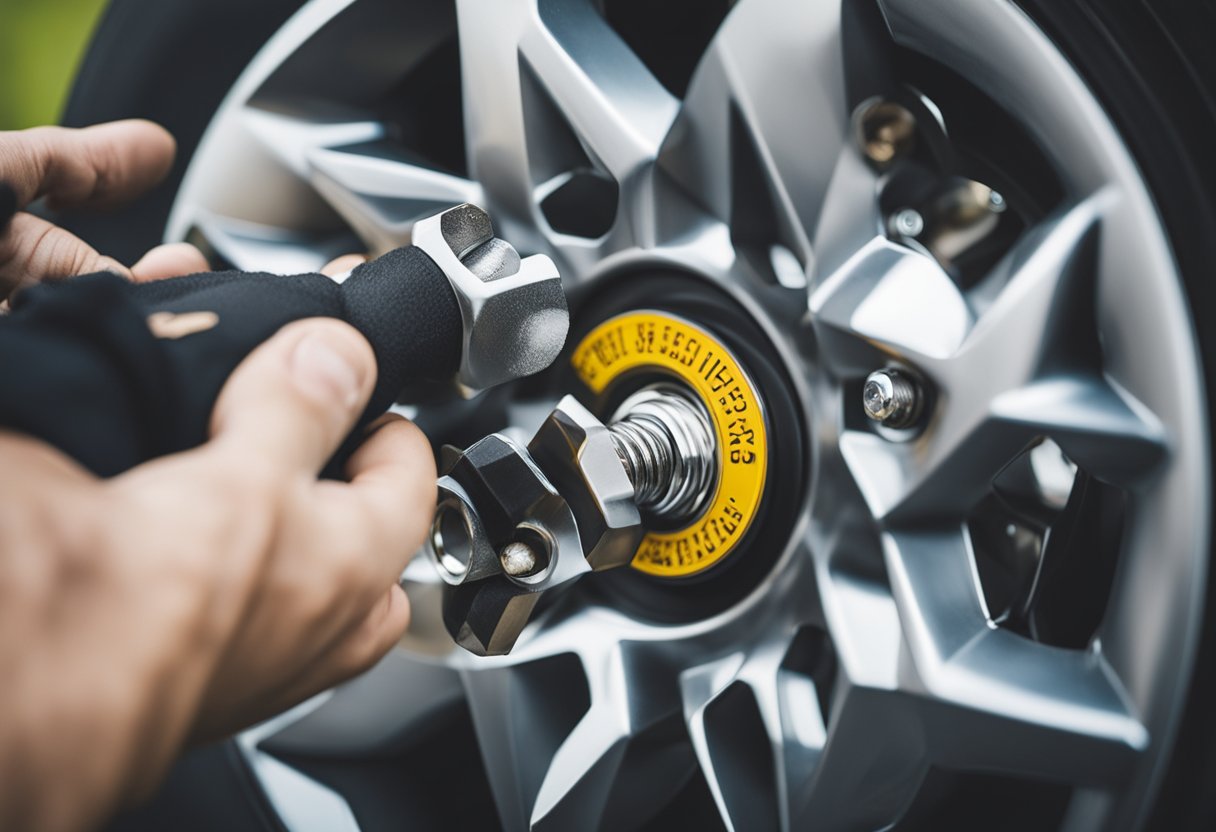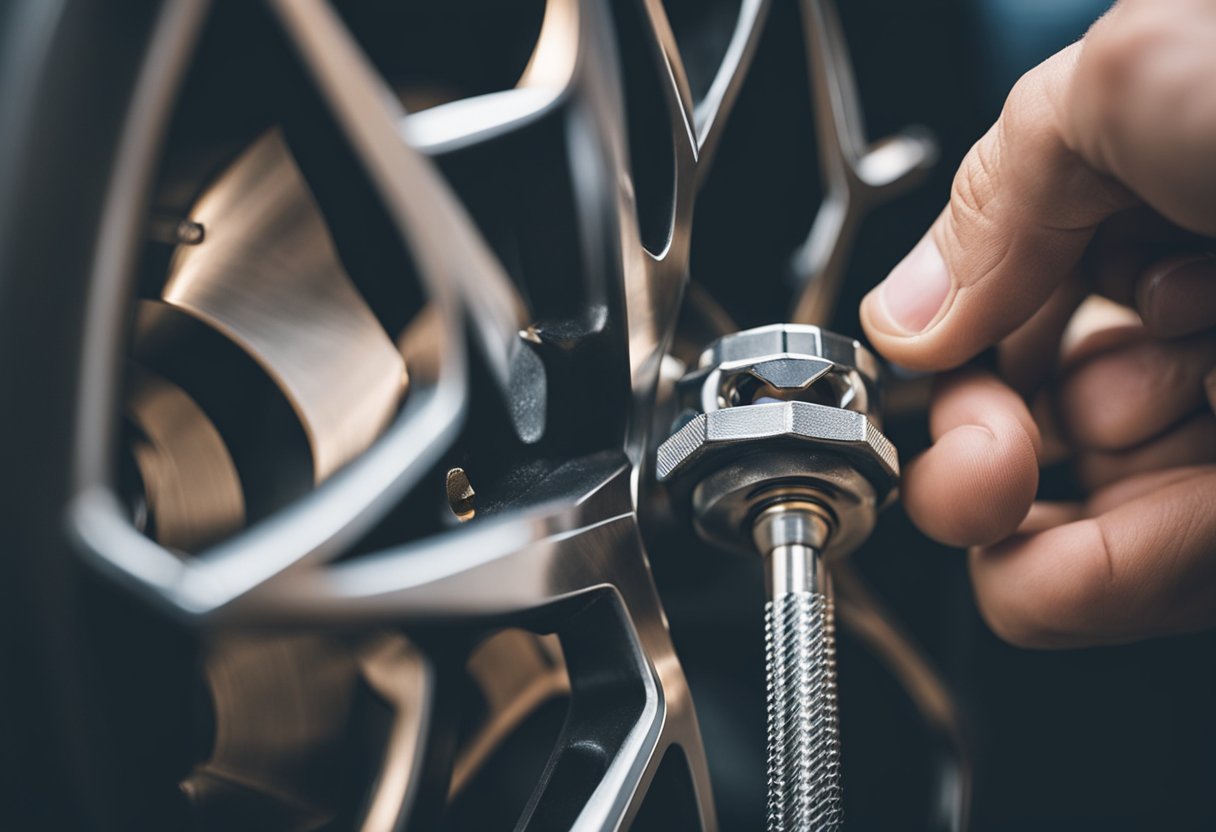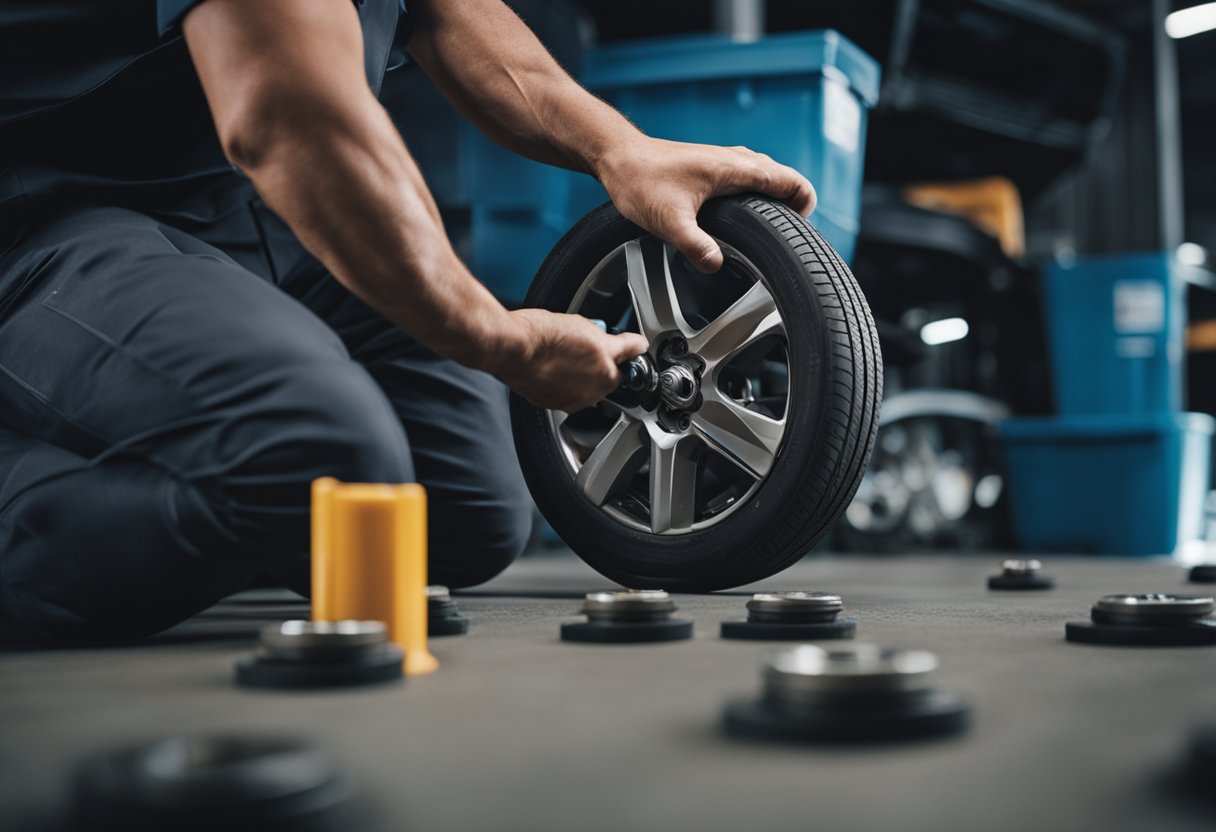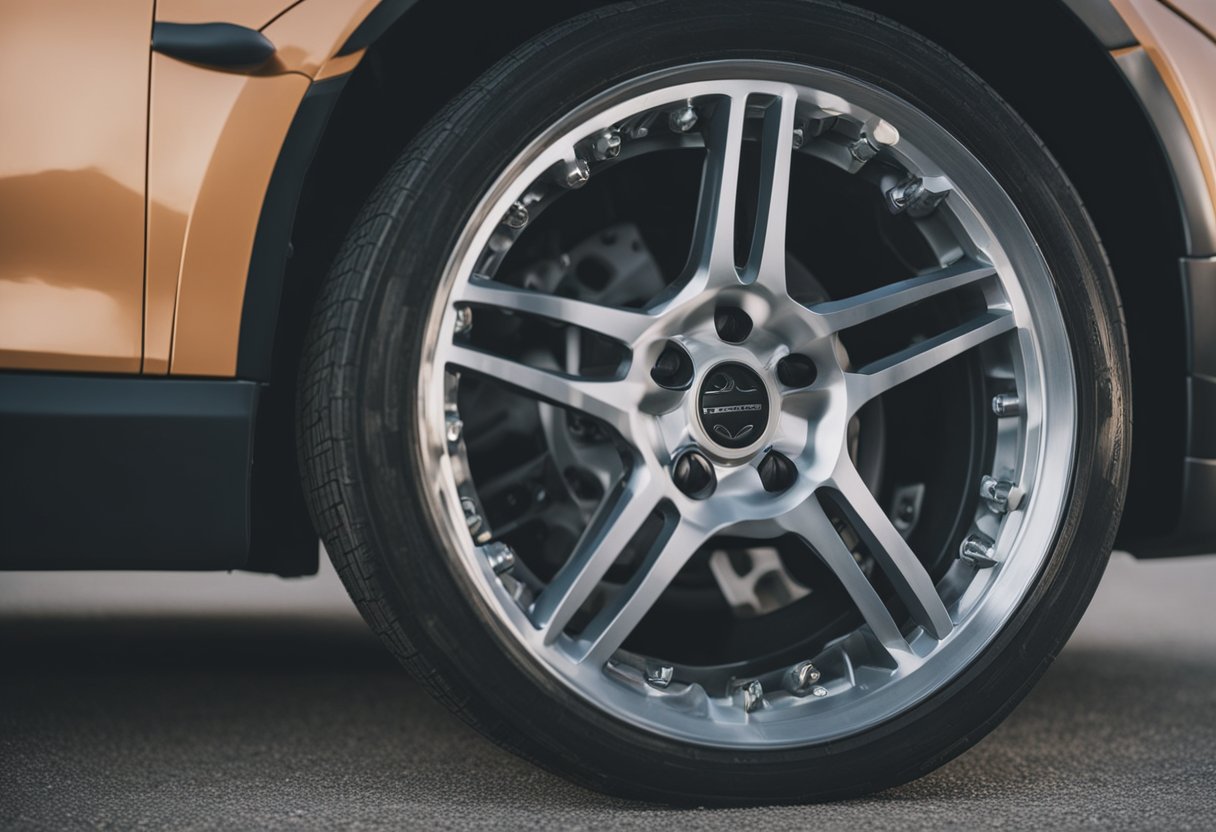Tightening lug nuts is an essential maintenance task that every car owner should know how to do. It ensures that the wheels are securely fastened to the vehicle, preventing accidents caused by loose wheels. While using a torque wrench is the most accurate way to tighten lug nuts, not everyone has one on hand. Fortunately, there are alternative methods to achieve the correct torque without a torque wrench.
Understanding lug nuts is the first step to tightening them properly. Lug nuts are the fasteners that hold the wheel to the hub. They come in different sizes and thread patterns, so it’s important to use the right size and type of lug nut for your vehicle. Using the wrong lug nut can damage the wheel or the stud, leading to costly repairs. Once you have the right lug nuts, you can start the process of tightening them.
Key Takeaways:
- Understanding the different types of lug nuts and their functions is essential before tightening them.
- Having the right tools for the job, such as a breaker bar and a torque stick, can make the process easier.
- There are alternative methods to achieve the correct torque without a torque wrench, such as the “hand tight” method and the “three-stage” method.
Understanding Lug Nuts
As a car owner, you may have heard of lug nuts, but do you know what they are and how they work? Lug nuts are the fasteners that secure the wheel to the hub of your vehicle. They are typically made of steel, but there are other materials such as titanium and anodized aluminum that can be used for their construction.
The size and thread pattern of the lug nuts are specific to each vehicle make and model. It is important to use the correct lug nuts for your vehicle to ensure proper fitment and safety. Using the wrong size or type of lug nut can cause damage to the wheel or hub, and can even cause the wheel to come off while driving.
When it comes to tightening lug nuts, it is important to use the correct torque specification. Over-tightening or under-tightening the lug nuts can cause damage to the wheel, hub, or lug nut itself. While a torque wrench is the best tool for the job, there are alternative methods to tighten lug nuts without a torque wrench.
One method is the “Hand Tight” method. This involves tightening the lug nuts as much as you can manually, ensuring they are snug and secure. However, it is important to note that this method may not be as accurate as using a torque wrench, and it may be difficult to achieve the same level of tightness on each lug nut.
Another method is using a lug wrench. This tool can be used to tighten lug nuts, but it is not a substitute for a torque wrench. It is important to use the lug wrench correctly and not to over-tighten the lug nuts.
Overall, understanding lug nuts and their importance in securing your vehicle’s wheels is crucial. Using the correct lug nuts and torque specification, as well as ensuring proper tightness, can help prevent damage to your vehicle and ensure your safety while driving.
Essential Tools for the Task
https://www.youtube.com/watch?v=gd0D3z1_5ws&embed=true
As a mechanic, I know that it is essential to have the right tools to get the job done correctly. When it comes to tightening lug nuts without a torque wrench, having the right tools is even more critical. Here are some of the essential tools that I recommend for the task:
Lug Wrench
A lug wrench is a tool that is used to tighten and loosen lug nuts. It is a simple tool that is often included with your car’s spare tire. If you do not have a lug wrench, you can purchase one at any auto parts store. A lug wrench is a must-have tool for tightening lug nuts without a torque wrench.
Breaker Bar
A breaker bar is a long-handled tool that is used to apply torque to a nut or bolt. It is an essential tool for removing tight lug nuts. A breaker bar is a great tool to have on hand when tightening lug nuts without a torque wrench. It allows you to apply more force to the lug nut than you could with a regular wrench.
Extendable Breaker Bar
An extendable breaker bar is a type of breaker bar that can be adjusted to different lengths. This tool is great for reaching lug nuts that are in hard-to-reach places. It is also useful for applying more force to a lug nut when tightening it.
Socket Set
A socket set is a collection of sockets of different sizes that are used to tighten and loosen nuts and bolts. It is an essential tool for any mechanic or DIY enthusiast. When tightening lug nuts without a torque wrench, a socket set is a must-have tool. It allows you to apply more force to the lug nut than you could with a regular wrench.
Jack
A jack is a tool that is used to lift a vehicle off the ground. It is an essential tool for changing a tire. When tightening lug nuts without a torque wrench, a jack is also a must-have tool. It allows you to access the lug nuts more easily.
Tire Iron
A tire iron is a tool that is used to remove and tighten lug nuts. It is a simple tool that is often included with your car’s spare tire. If you do not have a tire iron, you can purchase one at any auto parts store. A tire iron is a great tool to have on hand when tightening lug nuts without a torque wrench.
Impact Wrench
An impact wrench is a power tool that is used to tighten and loosen nuts and bolts. It is an essential tool for any mechanic or DIY enthusiast. When tightening lug nuts without a torque wrench, an impact wrench is a great tool to have on hand. It allows you to apply more force to the lug nut than you could with a regular wrench.
Clutch Alignment Tool
A clutch alignment tool is a tool that is used to align the clutch disc with the pressure plate. It is an essential tool for any mechanic or DIY enthusiast. When tightening lug nuts without a torque wrench, a clutch alignment tool is not necessary. However, it is a great tool to have on hand if you are also working on your clutch.
Cross-Bar Wrench
A cross-bar wrench is a type of tire iron that has a crossbar for added leverage. It is a great tool to have on hand when tightening lug nuts without a torque wrench. It allows you to apply more force to the lug nut than you could with a regular tire iron.
Preparation Before Tightening Lug Nuts
Before tightening your lug nuts, it is important to ensure that you have all the necessary tools and equipment. This will help you to complete the task quickly and safely. Here are some steps to follow before tightening your lug nuts:
-
Safety First: Safety should always be your top priority. Make sure that you are working in a safe environment and that the car is parked on a level surface. Also, make sure that the car is turned off and that the parking brake is engaged.
-
Check the Wheels: Before tightening the lug nuts, check the wheels to make sure that they are clean and free of debris. This will help to ensure that the lug nuts are properly seated and tightened.
-
Flat Tire: If you are tightening the lug nuts because of a flat tire, make sure that you have a spare tire that is properly inflated and in good condition. Also, make sure that you have a jack and lug wrench in your trunk.
-
Jack Up the Car: Use a jack to lift the car off the ground. Make sure that you place the jack in the correct location, as specified in your owner’s manual. This will help to ensure that the car is stable and secure while you are working on it.
-
Remove the Lug Nuts: Use a lug wrench to remove the lug nuts from the wheel. Make sure that you keep the lug nuts in a safe place, so that you don’t lose them.
-
Spare Tire: Remove the flat tire and replace it with the spare tire. Make sure that you tighten the lug nuts by hand, so that the spare tire is properly seated.
-
Toolbox: Keep a toolbox in your car with all the necessary tools and equipment, including a lug wrench, jack, and spare tire. This will help you to be prepared for any situation that may arise while you are on the road.
By following these steps, you can ensure that you are properly prepared to tighten your lug nuts. This will help you to complete the task quickly and safely, and ensure that your car is ready to hit the road.
Methods to Tighten Lug Nuts without Torque Wrench
https://www.youtube.com/watch?v=X2skHgRo0xg&embed=true
As a car owner, it is essential to know how to tighten lug nuts without a torque wrench. In case you don’t have a torque wrench, you can still tighten your lug nuts using various methods. Here are some of the methods that you can use to tighten lug nuts without a torque wrench:
Using Your Hands
One of the simplest methods of tightening lug nuts without a torque wrench is using your hands. You can use a lug wrench to loosen the lug nuts and then use your hands to tighten them. However, it is important to note that this method is not as accurate as using a torque wrench.
Count and Turn Technique
The count and turn technique is another method that you can use to tighten lug nuts without a torque wrench. This method involves tightening the lug nuts by a certain number of turns. For instance, you can tighten the lug nuts by three full turns after they have been hand tightened. This method is not as accurate as using a torque wrench, but it is better than using your hands.
Body Weight
You can also use your body weight to tighten lug nuts without a torque wrench. This method involves standing on the wrench to provide additional torque. However, this method is not recommended as it can damage the wrench or the lug nuts.
Reverse Torque Technique
Another method that you can use to tighten lug nuts without a torque wrench is the reverse torque technique. This technique involves tightening the lug nuts in the opposite direction and then tightening them in the correct direction. This method is not as accurate as using a torque wrench, but it is better than using your hands.
In conclusion, while it is possible to tighten lug nuts without a torque wrench, it is important to note that these methods are not as accurate as using a torque wrench. It is always recommended to use a torque wrench to ensure that the lug nuts are tightened to the manufacturer’s specifications.
Avoiding Common Pitfalls
https://www.youtube.com/watch?v=gdfROk3-xCg&embed=true
When tightening lug nuts without a torque wrench, it is important to be aware of some common pitfalls that can occur. These pitfalls can lead to overtightening, under-tightening, or damage to the threads, which can result in stripped threads. Here are some tips to avoid these pitfalls:
1. Do Not Overtighten
One of the most common pitfalls when tightening lug nuts without a torque wrench is overtightening. Overtightening can cause damage to the threads, which can result in stripped threads. To avoid overtightening, it is important to use a lug wrench or breaker bar and tighten the lug nuts in a star pattern. This will ensure that the lug nuts are tightened evenly and prevent overtightening.
2. Do Not Under-Tighten
Under-tightening is another common pitfall when tightening lug nuts without a torque wrench. Under-tightening can cause the lug nuts to loosen over time, which can lead to a dangerous situation while driving. To avoid under-tightening, it is important to use a lug wrench or breaker bar and tighten the lug nuts as much as possible manually, ensuring they are snug and secure.
3. Avoid Damaging the Threads
When tightening lug nuts without a torque wrench, it is important to avoid damaging the threads. Damaging the threads can cause the lug nuts to become loose over time, which can lead to a dangerous situation while driving. To avoid damaging the threads, it is important to use a lug wrench or breaker bar and tighten the lug nuts in a star pattern. This will ensure that the lug nuts are tightened evenly and prevent damage to the threads.
4. Do Not Strip the Threads
Another common pitfall when tightening lug nuts without a torque wrench is stripping the threads. Stripping the threads can cause the lug nuts to become loose over time, which can lead to a dangerous situation while driving. To avoid stripping the threads, it is important to use a lug wrench or breaker bar and tighten the lug nuts in a star pattern. This will ensure that the lug nuts are tightened evenly and prevent stripping the threads.
By following these tips, you can avoid common pitfalls when tightening lug nuts without a torque wrench. Remember to use a lug wrench or breaker bar and tighten the lug nuts in a star pattern to ensure that they are tightened evenly and securely.
Importance of Correct Torque
https://www.youtube.com/watch?v=DA4ug4gHccM&embed=true
As a mechanic, I know the importance of correctly torquing lug nuts on a vehicle. The correct torque ensures that the wheel is securely fastened to the hub, preventing it from coming loose while driving. It also helps to distribute the load evenly across the wheel and hub assembly, which can prevent damage to the wheel and other components.
When it comes to tightening lug nuts, the recommended torque for a particular vehicle can vary depending on the make and model. This information can usually be found in the owner’s manual or by contacting the manufacturer. It is important to follow the recommended torque specifications to ensure that the wheel is tightened to the correct level.
One of the best ways to ensure that lug nuts are tightened to the correct torque is by using a torque wrench. A torque wrench is a tool that allows you to tighten a bolt or nut to a specific torque value. This ensures that the bolt or nut is tightened to the correct level, preventing over-tightening or under-tightening.
If you don’t have a torque wrench, there are other methods you can use to tighten lug nuts. One method is the mathematical method. This involves using a formula to calculate the torque required based on the size of the lug nut and the thread pitch. However, this method can be time-consuming and requires some math skills.
Another method is to use your hands to tighten the lug nuts as much as you can, then use a lug wrench to tighten them further. This method can work, but it is not as accurate as using a torque wrench. It is important to be careful not to over-tighten the lug nuts, as this can cause damage to the wheel or hub assembly.
In conclusion, correctly torquing lug nuts is essential for the safety and longevity of your vehicle. While a torque wrench is the best tool for the job, there are other methods you can use if you don’t have one available. Just be sure to follow the recommended torque specifications and be careful not to over-tighten or under-tighten the lug nuts.
Post-Tightening Recommendations
After tightening the lug nuts without a torque wrench, it is important to follow some post-tightening recommendations to ensure the safety of your vehicle. Here are some of the recommendations that I suggest:
1. Check the Lug Nuts After Driving
After driving a short distance, it is important to check the lug nuts again to make sure they are still tight. This is because the lug nuts may loosen up due to the vibration caused by the movement of the vehicle. Checking the lug nuts after driving is a good practice to prevent any accidents due to loose wheels.
2. Visit a Repair Shop
If you are not confident in your ability to tighten the lug nuts properly, or if you suspect that something is wrong with your vehicle, it is best to visit a repair shop. A professional mechanic can inspect your vehicle and ensure that everything is in order.
3. Keep a Safe Distance
After tightening the lug nuts, it is important to keep a safe distance from other vehicles on the road. This is because loose wheels can cause accidents that can be fatal. Keeping a safe distance from other vehicles will give you enough time to react in case something goes wrong.
4. Work with a Team
If you are working on a vehicle with multiple wheels, it is best to work with a team. This is because it can be difficult to tighten the lug nuts properly on your own. With a team, you can work together to ensure that everything is done correctly.
In conclusion, tightening lug nuts without a torque wrench is possible, but it is important to follow some post-tightening recommendations to ensure the safety of your vehicle. Checking the lug nuts after driving, visiting a repair shop, keeping a safe distance, and working with a team are some of the things you can do to prevent accidents and ensure that your vehicle is in good condition.
Frequently Asked Questions
How tight should you tighten your lug nuts?
When tightening lug nuts without a torque wrench, it is important to ensure that they are tightened to the correct torque specification. The torque specification can usually be found in your vehicle’s owner’s manual or online. It is important not to over-tighten the lug nuts, as this can cause damage to the wheel and potentially cause it to come loose while driving.
How to tighten lug nuts with impact wrench?
An impact wrench can be a useful tool for tightening lug nuts, but it is important to use it correctly. First, ensure that the impact wrench is set to the correct torque setting for your vehicle. Then, use the impact wrench to tighten each lug nut in a criss-cross pattern, gradually increasing the torque until each nut is tightened to the correct specification.
How to know if your lug nuts are tight enough?
One way to check if your lug nuts are tight enough is to use a torque wrench. If you do not have a torque wrench, you can check the tightness of the lug nuts by using a lug wrench to try and loosen them. If the lug nuts are still tight, they are likely tightened to the correct specification.
Is it safe to tighten lug nuts without torque wrench?
While it is possible to tighten lug nuts without a torque wrench, it is important to ensure that they are tightened to the correct specification. Over-tightening or under-tightening lug nuts can cause damage to the wheel and potentially cause it to come loose while driving.
Can you tighten lug nuts with an impact wrench?
Yes, an impact wrench can be used to tighten lug nuts, but it is important to use it correctly. See the previous section for more information.
How do you tighten lug nuts by hand?
To tighten lug nuts by hand, use a lug wrench to tighten each nut in a criss-cross pattern, gradually increasing the torque until each nut is tightened to the correct specification. It is important not to over-tighten the lug nuts, as this can cause damage to the wheel and potentially cause it to come loose while driving.

Hi, I’m Sal Muller of Tooltrip.com. My DIY experience led me to understand essential power tools for home projects. Tooltrip.com guides enthusiasts and professionals in choosing right tools for any job. I provide concise top tool reviews for easier, efficient DIY.






